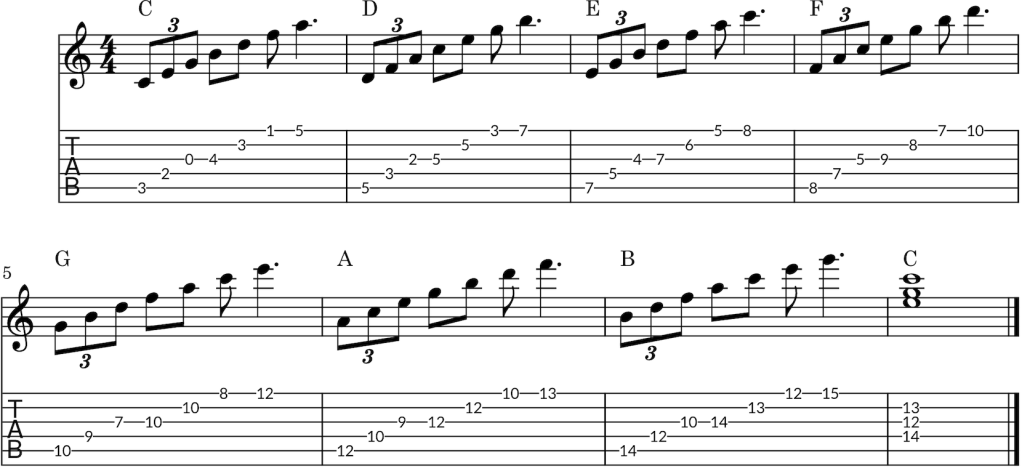
Extended harmony takes all the fun of music and ruins it with a bunch of numbers. It’s also very important because it reveals the hidden link between chords and scales.
But all those numbers don’t have to be confusing.
Chords are built in thirds (playing every other note in the scale). The most basic chord is called a triad, which consists of a root, 3rd, and a perfect fifth. Just skip the even-numbered notes, like this:
1 (2) 3 (4) 5
A triad only uses three of the seven notes in the diatonic scale. What if we add a fourth note? How about a fifth note. Or sixth. Or seventh?
That’s where chord extensions come into play.
There are only four chord extensions in any key: 7, 9, 11, and 13. These four extensions can be altered (raised or lowered) to achieve different levels of tension within a chord. The 9, 11, and 13 are named for their position in a stack of thirds.
The following sections will go into more detail about chord extensions, and how they can be useful for guitar players.
How Extensions Get Their Names
If you haven’t spent at least a few years studying music theory, it can be a little overwhelming to see numbers like 9, 11, and 13 next to a chord. After all, there are only seven notes in a major scale.
Where did all those extra notes come from?
It’s actually pretty simple. Here is what a C major scale looks like if we extend it out for two octaves:
| C | D | E | F | G | A | B | C | D | E | F | G | A | B |
| 1 | 2 | 3 | 4 | 5 | 6 | 7 | 8 | 9 | 10 | 11 | 12 | 13 | 14 |
The first octave includes the numbers 1 through 7. Most musicians who have learned a few scales understand how to count scale degrees. You may even know that a major 7, minor 7, or dominant 7 chord is built with the formula 1-3-5-7.
The second octave is where we get the numbers for chord extensions. A stack of seven thirds coverers all seven notes in the scale. Here is the same table, with every other number removed:
| C | D | E | F | G | A | B | C | D | E | F | G | A | B |
| 1 | 3 | 5 | 7 | 9 | 11 | 13 |
The 9, 11, and 13 are the notes that would have fallen between the 1, 3, 5, and 7.
If we wanted to build a massive Stack-O-Thirds from each note in the C major scale, it would look like this:
- C (D) E (F) G (A) B (C) D (E) F (G) A
- D (E) F (G) A (B) C (D) E (F) G (A) B
- E (F) G (A) B (C) D (E) F (G) A (B) C
- F (G) A (B) C (D) E (F) G (A) B (C) D
- G (A) B (C) D (E) F (G) A (B) C (D) E
- A (B) C (D) E (F) G (A) B (C) D (E) F
- B (C) D (E) F (G) A (B) C (D) E (F) G
The larger, bolded notes are the 1, 3, 5, 7, 9, 11, and 13. The notes indicated with smaller text and parentheses are the even-numbered notes.
How Chord Extensions Work on Guitar
You will rarely find chords in the real world that use seven different notes. It might sound interesting sometimes, maybe even beautiful. More often it will make the arrangement sound cluttered.
Unlike piano, or a multi-piece orchestra, a six-string guitar can only play a maximum of six notes at a time. Standard tuning makes it difficult to reach six different notes at once.
Any way you slice it, it’s not practical to play a full chords with all four extensions. How do we solve these practical problems?
Simple. Play fewer notes.
The usual way of playing a 9, 11, or 13 chord is to strip the chord down to its essentials. You need the following:
- The root note
- The 3rd to establish whether the chord is major or minor
- The 7th
- One or more extensions
The root, 3rd, and 7th give our ears enough information that we can leave out the 5th.
Often we can leave out the root, as well, if a bass or another instrument is already covering that note. Freddie Green, who played guitar for the Count Basie Orchestra, typically only played the 3rd and 7th, or the 3rd and an extension. Playing fewer notes allowed him to cut through the large orchestra.
Extended Arpeggios
There is another way to play chord extensions on guitar. Since we can’t play all seven notes at once, we can play the notes one at a time as an arpeggio.
Because the fretboard has lots of repeating notes, it is possible to play these arpeggios using different fingerings and positions.

This exercise will help improve your ability to visualize notes and chords all over the neck. Once you have a grasp of C major, try practicing this exercise in the other 11 keys.
Altered Extensions
You may have heard of an “altered dominant” chord. That is a dominant chord (1-3-5-b7) with a raised or lowered extension.
Because the chromatic scale only has 12 notes, and because each diatonic scale includes two half-step intervals, there are only a few ways to alter an extension.
These are the four most common altered extensions:
- Flat 9
- Sharp 9
- Sharp 11
- Flat 13
Yes, there are other possible alterations, but they are redundant and can be confusing. For instance, a flat 11 is the same as a major 3. Altered extensions are typically only played over dominant chords, which already have a major 3.
The following chart condenses the Cmaj13 chord into a single octave with all of the altered extensions.
| C | C#/Db | D | D#/Eb | E | F | F#/Gb | G | G#/Ab | A | A#/Bb | B |
| 1 | b9 | 9 | #9 | 3 | 11 | #11 | 5 | b13 | 13 | (b7) | 7 |
Notice the flat 7 has been included with parentheses. While it is common to use a flat 7 to describe a scale or mode—the Dorian, Phrygian, Mixolydian, and Aeolian modes all have a flat 7—it is not considered an altered tone.
Instead, 7 chords are named for their quality: major, minor, or dominant. Also, like the earlier example of a flat 11, a flat 7 is already present in a dominant chord. Altered extensions are almost exclusively played over dominant chords.
The Names of Each 13th Chord
You may be left wondering what to call the chords built from all these extensions. Most of them have funny names. Maybe you’ve seen them written on a lead sheet or a chord chart. That could even be the reason you ended up on this article.
If you’ve read up to this point, you already have the tools to figure out how to name these crazy seven-note chords. But if you just want to know the answer, here are the names of all the extended chords in C major.
| Chord | Root | Full Extensions |
|---|---|---|
| I | C | C Major 13 |
| ii | D | D Minor 13 |
| iii | E | E Minor b9 b13 |
| IV | F | F Major 13 #11 |
| V | G | G13 |
| vi | A | A Minor b13 |
| viiº | B | B Diminished 7 b9 b13 |
The chord qualities are the same regardless of the key signature. All that changes are the notes of the scale. The altered tones reflect the differences between the modes of the major scale. For example C is a “major 13” because it has a major 7, while G is simply G13 because it has a dominant 7.
As mentioned above, you would never play these chords in their entirety on guitar. Knowing the altered extensions for each chord in the scale is very useful for avoiding sour notes in a melody or solo part.

Leave a comment